Nor Baizura Bt Hamid1, Masiri B. Kaamin1, Mardiha Bt Mokhtar1, Aslila Bt Abd Kadir1, Siti Khatijah Bt Abu Bakar2, Nurul Huda Bt Ibrahim2
1Centre for Diploma Studies, UTHM
2Faculty of Civil and Environmental Engineering, UTHM
Correspondence to: Nor Baizura Bt Hamid, Centre for Diploma Studies, UTHM.
| Email: |  |
Copyright © 2015 Scientific & Academic Publishing. All Rights Reserved.
Abstract
Utricularia Aurea (lumut rayap) is an aquatic plant that has the ability to supply oxygen during photosynthesis process and eliminate pollutant material such includes organic material, nitrate and suspended solid. This study was carried out to investigate the potential of Utricularia Aurea in replacing air pump and filter in the aquarium. The effectiveness of Utricularia Aurea were tested with seven parameters such as temperature, dissolved oxygen (DO), pH value, total suspended solid, turbidity, chemical oxygen demand (COD) and nitrate for approximately 18 days. Three samples of aquarium that have the same volume of water were prepared as to compare the effect of using Utricularia Aurea with conventional system. It was found that Utricularia Aurea can produce natural source of oxygen in the aquarium. Results Utricularia Aurea showed that the optimum value produced for DO is 1.40mg / L, pH is 6.41, total suspended solids is 155mg / L, turbidity is 37.05 NTU, COD is 146mg / L and nitrate is 0.139mg / L. Thus it is believe that Utricularia Aurea has the potential in increasing the oxygen level in aquarium than that of the conventional system and also economic as it can be found easily.
Keywords:
Utricularia Aurea, temperature, Dissolved oxygen, pH value, Total suspended solid, Turbidity, COD, Nitrate
Cite this paper: Nor Baizura Bt Hamid, Masiri B. Kaamin, Mardiha Bt Mokhtar, Aslila Bt Abd Kadir, Siti Khatijah Bt Abu Bakar, Nurul Huda Bt Ibrahim, Research on the Effectiveness of an Aquatic Plant (Utricularia Aurea) for Fish Preservation, Journal of Civil Engineering Research, Vol. 5 No. 4A, 2015, pp. 1-5. doi: 10.5923/c.jce.201501.01.
1. Introduction
Ornamental fish becomes a trend nowadays and being phenomena in the world where Malaysia is one of the major exporters of ornamental fish. Few countries which became Malaysia’s main suppliers are Japan, Indonesia, Germany, Hong Kong, China, Australia and also Brunei [1]. When talking about the ornamental fish industry, it also means aquarium equipment, stone and sand, the food, medicines and also aquatic plants. Malaysia has become one of export countries for aquatic plant with Johor as the producer in here whereas Singapore has become the main import country for the stated matter. In Malaysia there are over 200 species of aquatic plant been exported which are Riccia fluitans, Azolla japonica, Salvinia auriculata, Marsilea angustifolia, Ceratopteris thalictroides, Bolbitis heudelotii and few others. This study was carried out to investigate the potential of aquatic plant in replacing air pump and filter in the aquarium and also to show that Utricularia Aurea have a benefit potential in producing oxygen that can replace the conventional system.
2. Literature Review
Utricularia Aurea (Lumut rayap) is a type of aquatic plant found on water surface. There are almost 233 species of carnivorous plants and this type of aquatic plants grows in ponds and drains. The flower is yellow in color and appear vertically on water surface from 10 to 25 cm. Utricularia Aurea flowers from May to October and live under the water. The leaves are sunken and divide into tiny segment with large numbers of small bladder. Those bladders spread out and functioned as a food supplier and to trap small insects. Aquatic plants have those active parts that are able to carry out photosynthesis process for their survival. All these plant’s photosynthetic tissues live in the water. Its stem and leaf are soft because of small number of lignin and long structure. Furthermore, this plant is able to resist the water movement and stays fixed. Its bud stays on water surface and them generally does not touching [2].
2.1. Habitat of Utricularia Aurea
Aquatic plants live in aquatic environments (rice field, river, lake, drainage) but they don’t cover marine area of mangrove swamp. Water weeds are experiencing rapid growth causes a great loss to Malaysia’s farmers and there are many efforts have been taken to overcome the problems. One of them is through biological control such as fish, pesticide, cutting machine and others [3]. Aquatic plants are natural resources with potential to reduce nutrient amount in polluted water besides that, aquatic plants also are important subtracts for artistic organism’s attachment which live in the water. [4].
2.2. Significance of Utricularia Aurea
Aquatic plants are most important component in aquatic ecosystem. Their importances are in producing oxygen through photosynthesis process, providing living places for small fishes and protecting the river bank from corrosion. Aquatic plants are natural habitat and primary food source for aquatic animals especially fishes where ‘Kap’ and ‘Tilapia’ fish usually eat this plants. Some aquatic plants like Atricularia Aurea have different life suitability with other species. It can live in moving water area. Lighting is one of physicals factors which affect the diversity of aquatic plants. Most of aquatic plants need low light intensity. High light intensity will not only cause retardation of photosynthesis process but also increase the transpiration rate. Suitable light intensity for aquatic plants growth is 10,000 to 20,000 lux. Other meteorology characteristic such as cloud, haze and gas are able to reduce the amount of light enters the aquatic environment through absorbance, reflection and refraction of the sunlight [5].
2.3. Requirements Cultivation of Aquatic Plants in the Aquarium
Aquatic plants claim three needs to remain live in aquarium which are:i. Carbon DioxidePlants need carbon dioxide to carry out photosynthesis process in compensate to humans’ need for oxygen to breath. Carbon dioxide is needed for a good growth. This gas can actually be bought in certain shops and if this gas is not supplied, plants can still live because the gas is readily made in the water through respiration.ii. FertilisersFertiliser is needed to supply mineral nutrients for aquatic’s plants growing process. Liquid fertiliser or seeds need to be updated from time to time by using available fertilisers in market by applying suggested methods.iii. LightingLight is needed for photosynthesis process. Therefore, aquarium tank must be equipped with light for 10 to 12 hours per day.
2.4. Aquarium System
The structure of the aquarium made up of glass because it can resist high pressure and cheap. Aquarium for fish preservation must be selected according the fish to be preserved. There are several sizes and shapes that can be purchased such as round, square and so on. There are some tools that are vital for creating a good and effective aquarium [1].An aquarium should be cleaned every week or at least every two weeks. Oxygen and accessories will be muddied after being used for some period of time. Dust in the aquarium will affect the oxygen content in the aquarium and water quality. This caused by fish, excess food, algae, bacteria and fleas.
2.5. Air Pump
Air pump is a pump used in the water. Its function is similar to the air pump but used in conjunction with a filtration system. The main function is to produce enough oxygen. There is an electric motor that can rotate a small fan (impeller) inside the pump head that create vacuum condition to suck and remove the water through funnel. Water pump can also be used to circulate the water. From the aquarium into the filtration system, then back to the aquarium.
2.6. Filter
Filter is vital in an aquarium system. Its function is to ensure the quality of water to be clean and clear and suitable for fish, aquatic and aquatic plants. Clean and clear water not only beautiful, but also eliminate unwelcome smells of toxic gases due to contamination. Hence, an effective filtering system is important.
3. Methodology
This study was conducted with seven parameters such as temperature, dissolved oxygen (DO), pH value, total suspended solid, turbidity, chemical oxygen demand (COD) and nitrate for approximately 18 days. Three samples of aquarium that have the same volume of water were prepared.
3.1. Sample Preparation
In this experiment, three samples of aquariums with dimension 600mm x 300mm x 310mm were used and having 45 litres of water mixed with anti-chlorine. Each aquarium is using three different systems which classified as Sample 1, Sample 2 and Sample 3. Sample 1 was using the conventional system containing air pump and filter (Figure 3.1). The air pump and filter were then replaced with Utricularia Aurea for Sample 2 and Sample 3 (Figure 3.2 and 3.3 respectively). Utricularia Aurea can be easily found and for the purpose for this study, it was taken from the trench nearby Taman Wira Jaya, Parit Raja Johor. In order to achieve the aim of this paper, fish were added into Sample 1 and Sample 2 while Sample 3 was used as a control. The three samples were placed under the sunlight and Utricularia Aurea was used to cover 80 percent of the water surface.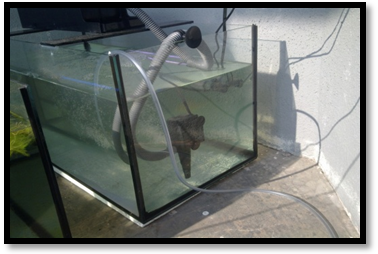 | Figure 3.1. Sample 1 represents aquarium fish preservation with conventional system of air pump and filter |
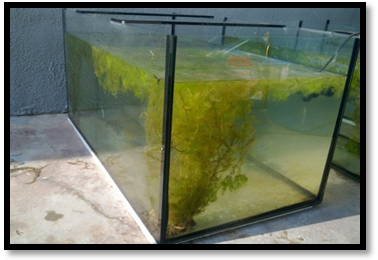 | Figure 3.2. Sample 2 represents aquarium fish preservation with Utricularia Aurea |
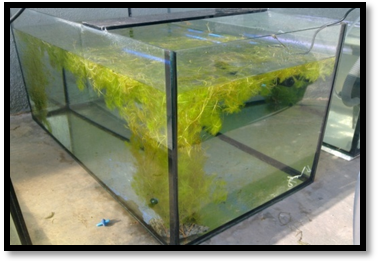 | Figure 3.3. Sample 3 represents the control sample |
3.2. Laboratory Experiment
The experiment was performed at least seven times. The entire three samples are tested in the laboratory at day 0, day 3rd, day 6th, day 9th, day 12th, day 15th and day 18th. The parameters considered are temperature, dissolved oxygen (DO), pH value, total suspended solids (TSS), turbidity, chemical oxygen demand (COD) and nitrate.
4. Results and Discussions
The potential of Utricularia Aurea to be used in fish preservation was assessed by the measurement of temperature, DO, pH, total suspended solid, turbidity, COD and nitrate. Below are details of each sample:| Table 4.1. Sample details |
| | Sample 1 | Water +air pump and filter system + fish | | Sample 2 | Water + Utricularia Aurea + fish | | Sample 3 | Water + Utricularia Aurea |
|
|
4.1. Results and Analysis for Temperature
Figure 4.1 shows the water temperature for each sample. Temperature is a basic characteristic which is important in water because each organism there is a thermal death point. Also there is a range of temperature of that produces optimal abundance. Temperature will affect to reduce gas solubility, hasten chemical reaction and it brings taste and smell to the water. | Figure 4.1. Water temperature of each sample |
4.2. Results and Analysis for Dissolved Oxygen
Figure 4.2 showed the dissolved oxygen data for the three samples. Based on the graph the optimum value obtained for dissolved oxygen for Sample 1 was 7.33mg/L on Day 18, Sample 2 was 4.53mg/L on Day 9 and Sample 3 was 6.89mg/L on Day 18. As can be seen from the graph, oxygen in Sample 1 continuously increases until the final test. This is because there is an air pump can supply enough oxygen for the fish. For Sample 2, the optimum dissolves oxygen only at Day 9 and begins to decline until the end of the test. The process of photosynthesis from Utricularia Aurea cannot supply enough oxygen and for a long time. Data from Sample 3 proves that Utricularia Aurea may supply oxygen but it doesn't have the capability to fulfil oxygen needs for longer span. | Figure 4.2. Dissolved oxygen’s analysis |
4.3. Results and Analysis for pH Values’ Parameter
Figure 4.3 shows pH value for Sample 1, 2 and 3. pH value for the three samples on Day 0 is same which is 6.88 whereas on Day 3, Sample 2 shows the pH value decrement which is more acidic that is 5.95 compared to Sample 1 with pH 6.66 and Sample 3 is 6.37. pH value for Sample 1 and 3 is stable on Day 9 until Day 18. On the 18th day, Sample 2 shows acidic condition with pH 6.41.From the bar chart, refer to value Sample 3 it shows that Utricularia Aurea has the potential to change pH to neutral. Suitable pH range for fish is from 6.0 to 9.0. If the pH is too low or high it will give the negative effect to the aquatic life. | Figure 4.3. pH value’s of each sample |
4.4. Results and Analysis for Total Suspended Solid (TSS) Parameter
Figure 4.4 showed the amount of suspended solids for Sample 1, 2 and 3. Based on the graph, optimum amount for sample 1, 2 and 3 are 108mg/L, 155mg/L, 8mg/L respectively. The results also showed the highest amount of suspended solid was in Sample 2. Utricularia Aurea acts as a filter by trapping the small particles within its root and the particles were attached to the aquatic plants temporarily. However, after a long period the roots cannot trap more particles and will cause the water turns muddy. The rate of photosynthesis is reduced due to the particles attached to the plants. At this point, the concentration of oxygen in the water subsequently reduced. Thus, the fish preservation would not be favourable within this condition. Based on the graph, Sample 3 shows a little difference. There is no/less activity or reaction which could lead to the production of suspended solid within the sample.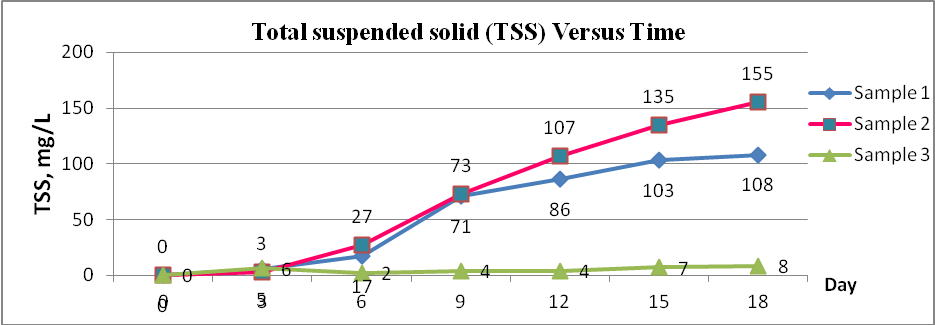 | Figure 4.4. Data of Total suspended solid |
4.5. Results and Analysis for Turbidity Parameter
Figure 4.5 showed the level of turbidity for Sample 1, 2 and 3. The results showed that highest turbidity was in Sample 2. The optimum value of turbidity for Samples 1, 2 and 3 were 28.82 NTU, 37.05 NTU and 2.19 NTU respectively. As can be seen from the graph, turbidity value in Sample 1 was still high and it happen because the filter has a tendency to move the water too fast, thus breaking the particulate matter into smaller pieces. The very small pieces tend to become suspended and water will turn into yellowish colour.The value of turbidity for Sample 2 is higher compared to Sample 1 because Utricularia Aurea roots cannot trap all the small particles. Therefore, to improve water quality the Utricularia Aurea should be washed or/and replaced regularly to remove the amount of small particles trapped. There are no particles in Sample 3 thus value of turbidity show the lowest compared the others.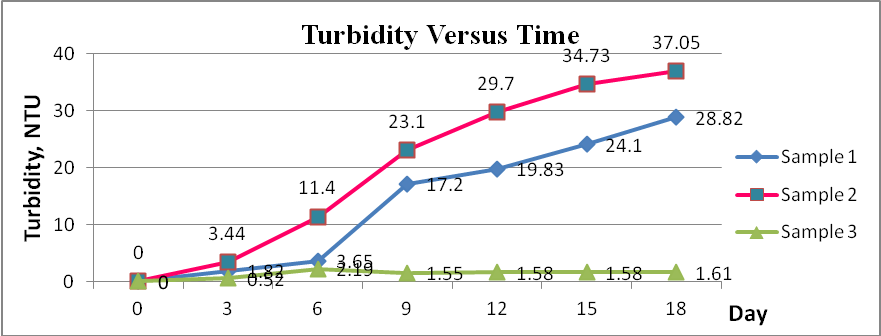 | Figure 4.5. Turbidity’s analysis |
4.6. Results and Analysis for Chemical Oxygen Demand (COD) Parameter
Figure 4.6 showed the chemical oxygen demand (COD) for Sample 1, 2 and 3. Based on the graph the optimum value obtained for COD for Sample 1, 2 and 3 were 119mg/L, 146mg/L and 75mg/L respectively. This is due to the increased amount of organic materials in Sample 1 and 2. Based on the graph, the quality of Sample 3 was highest because the value of COD readings is within range 50mg/L which is considered as clean.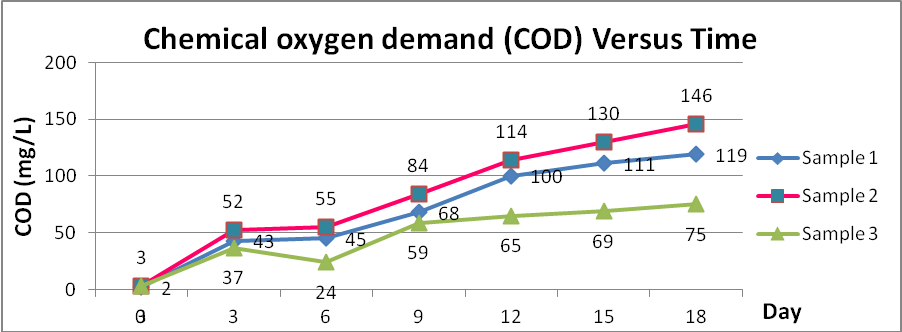 | Figure 4.6. Data of chemical oxygen demand |
4.7. Results and Analysis for Nitrate Parameter
Figure 4.7 showed the nitrate concentration for Sample 1, 2 and 3. Based on the graph, optimum nitrate concentration for Sample 1, 2 and 3 are 0.435mg/L, 0.139mg/L and 0.005mg/L respectively. As can be seen, Sample 1 is the highest compared the others but still less than 1 mg/L which were the natural level of nitrate.The difference in concentrations shows that the use of Utricularia Aurea in Sample 2 and 3 can reduce the concentration of nitrate. Utricularia Aurea use nitrate to build protein and aquatic animals that eat this plant also use organic nitrogen to build protein. But, the concentrations over 10 mg/L will have an effect on the aquatic environment.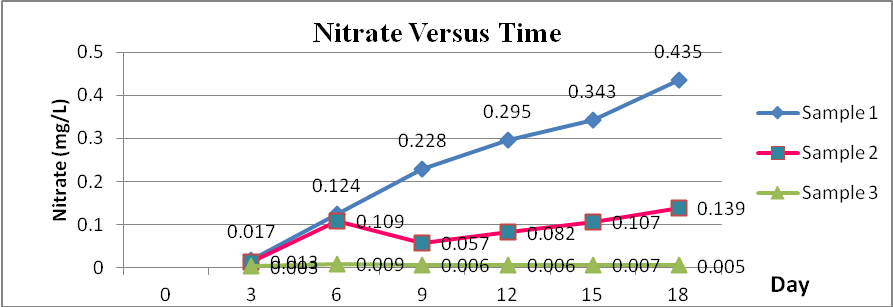 | Figure 4.7. Nitrate value’s analysis |
5. Conclusions
The results show that Utricularia Aurea has the potential in increasing the oxygen level in aquarium than that of the conventional system and also economic as it can be found easily. Utricularia Aurea is a potentially aquatic plant to stabilize the pH, reduce the chemical oxygen demand (COD) and also reduce the nitrate concentration. However, Utricularia Aurea is insufficient in trapping more particles after several days. It is recommended to be washed or replaced the Utricularia Aurea to improve the water quality. Additionally, Utricularia Aurea is for seen in contributing to reduce electricity consuming.
ACKNOWLEDGEMENTS
The author would like to thank the Faculty of Civil and Environmental Engineering of UTHM for providing the laboratory equipments to fulfil this study.
References
| [1] | Abdul Hamid Karim, Mudahnya Membuat Akuarium. Cerdik Publication Sdn. Bhd, 2005. |
| [2] | Cook, D.K.C., Bernado, J.G., Rix, E.M., Schneller, J. & Seitz, M, Water plants of the world: a manual for the identification of the genera of freshwater macrophytes. England: The Pitman, 1974. |
| [3] | Mohamad Soerjani, Soekisman Tjitrosemito, Southeast Asian Workshop on Aquatic weeds. Bogor, Indonesia: Southeast Asia Minister of Education, Regional Center for Tropical Biology, 1974. |
| [4] | Ahmad Ismail & Ahmad Badri Mohamad, Ekologi air tawar. Kuala Lumpur: Dewan Bahasa dan Pustaka, 1994. |
| [5] | Riemer, D.N, Introduction to freshwater vegetation. New York: Van Nostrand Reinhold, 1984. |











 Abstract
Abstract Reference
Reference Full-Text PDF
Full-Text PDF Full-text HTML
Full-text HTML